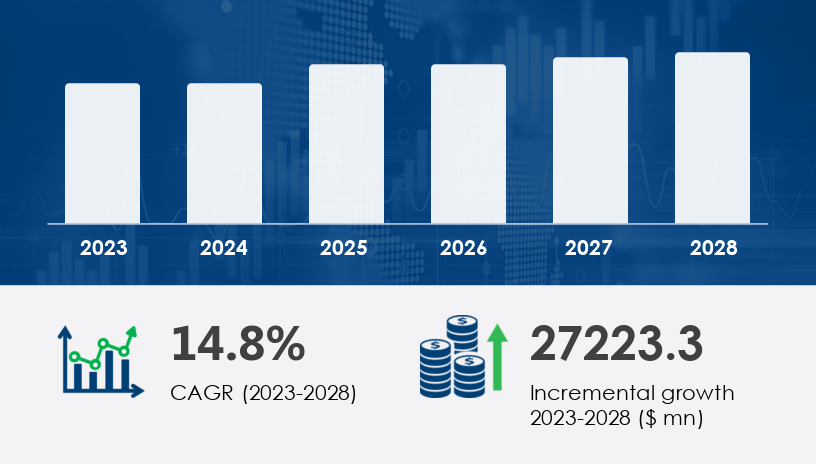The cloud computing market in the government sector is set to expand by USD 27.22 billion between 2024 and 2028, growing at a rapid CAGR of 14.8%.This remarkable growth trajectory is not just about technological evolution—it's a signal of a digital paradigm shift in public sector operations. As agencies grapple with growing cybersecurity demands, cross-functional inefficiencies, and public expectations for faster service delivery, cloud computing in the government sector emerges as a foundational pillar of modernization.For more details about the industry, get the PDF sample report for free

From federal to local levels, cloud computing is reshaping how government entities deliver services, manage data, and ensure security. The traditional limitations of on-premise systems—rigid infrastructure, high capital expenses, and isolated data silos—are giving way to the scalable, secure, and dynamic world of cloud ecosystems.
Government agencies are increasingly seeking unified platforms that allow different departments to collaborate seamlessly. Cloud platforms make this possible through shared services and interoperable systems.
“With cloud, we're building digital highways between agencies,” says Senior Technavio Expert
Security concerns are a major focus. Advanced encryption, real-time threat detection, and multi-layered security architecture now define leading cloud solutions.
Cloud-native security tools are tailored to combat the evolving sophistication of cyberattacks—especially crucial in government where sensitive citizen data is involved.
2025 Outlook: The hardware segment is positioned for robust growth, supported by the expanding use of Infrastructure-as-a-Service (IaaS) and Platform-as-a-Service (PaaS) models.
In 2018, the segment accounted for USD 8.37 billion, and it has since shown steady upward momentum. Modern cloud IT hardware supports high-throughput, real-time analytics, and mission-critical workloads in sectors ranging from public health to intelligent transport systems.
Get more details by ordering the complete report
With 43% market contribution, North America dominates due to strategic initiatives like the “Cloud First” policy introduced during the Obama administration. Government departments now leverage cloud for digital document management, automated workflows, and critical infrastructure protection.
Countries like China and Japan are investing heavily in smart governance, accelerating cloud adoption to support automated machinery, intelligent packaging, and data-driven policymaking.
The threat landscape is evolving fast. Governments are prioritizing investments in cloud-native cybersecurity solutions capable of responding to automated and AI-driven threats.
Packaging Insight: While seemingly unrelated, cloud computing also supports food safety in public welfare programs by powering intelligent packaging that monitors temperature and humidity in real-time.
Governments are exploring cloud-enabled biodegradable material innovations in public procurement and packaging, reducing the carbon footprint of operations—a growing priority worldwide.
While cloud offers long-term savings, governments often face short-term budget pressures from:
Bandwidth overuse
Service customization costs
Compliance and auditing requirements
Furthermore, legacy systems—still prevalent in many departments—often lack compatibility with modern cloud infrastructures, complicating integration.
"Cloud adoption must be part of a broader digital transformation plan—not a piecemeal upgrade," advises Senior Technavio Expert
For more details about the industry, get the PDF sample report for free
The Cloud Computing Market is expanding rapidly due to the growing demand for scalable, flexible, and cost-efficient IT infrastructure. Enterprises are increasingly adopting cloud infrastructure through deployment models such as public cloud, private cloud, and hybrid cloud, each offering varying degrees of control, scalability, and security. Key service models like IaaS platforms, PaaS solutions, and SaaS applications are enabling businesses to accelerate innovation while reducing operational costs. The integration of technologies such as big data, cloud analytics, machine learning, and AI platforms is driving deeper insights and automation across industries. To handle massive volumes of structured and unstructured data, organizations are investing in cloud storage, data lakes, and data warehouses, supported by robust cloud backup and disaster recovery solutions. The increased use of Kubernetes clusters and Docker containers also reflects a shift toward containerization for application scalability and portability, while cloud migration and managed services simplify IT transformation.
Evaluate cloud maturity: Assess organizational readiness and legacy constraints before migration.
Prioritize security: Build cybersecurity from the ground up with cloud-native solutions.
Think beyond IT: Leverage cloud for packaging innovations, logistics, and even food safety initiatives.
Foster cross-departmental collaboration: Implement shared platforms to boost inter-agency efficiency.
Get more details by ordering the complete report
CIOs and IT Leaders: Develop a hybrid cloud roadmap that aligns with national data regulations.
Procurement Officers: Include sustainability and scalability criteria in cloud service RFPs.
Policy Makers: Promote inter-agency data sharing via secure, centralized cloud platforms.
Vendors: Offer transparent pricing models and integration support to gain government trust.
Research into the Cloud Computing Market highlights the strategic importance of emerging technologies and compliance measures shaping enterprise adoption. The implementation of cloud security strategies such as zero trust, data encryption, and identity management is critical in ensuring secure access and protecting sensitive data. Compliance standards like FedRAMP compliance are particularly vital for government and regulated sectors. Organizations are leveraging cloud monitoring, cloud orchestration, and cloud automation to streamline operations, while cloud integration facilitates seamless connectivity between platforms. Architectures like microservices architecture and DevOps pipelines are enhancing software development and deployment. Additionally, the rise of serverless computing, cloud ERP, and digital twin technologies is transforming industries from manufacturing to healthcare. Innovations in edge computing, IoT platforms, and predictive analytics are driving smarter, real-time decision-making, particularly in critical areas like the supply chain and food safety. Moreover, the adoption of blockchain networks within cloud ecosystems further enhances transparency and traceability.
For more details about the industry, get the PDF sample report for free
As governments across the globe embrace digital transformation, cloud computing in the government sector will serve as both catalyst and conduit for change. From infrastructure modernization to improved citizen engagement and public safety, cloud technology holds the keys to a more agile, responsive, and cost-efficient government.
Safe and Secure SSL Encrypted